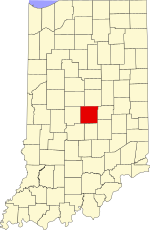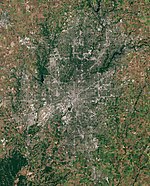Marion County, Indiana
Marion County | |
|---|---|
 | |
 Location within the U.S. state of Indiana | |
 Indiana's location within the U.S. | |
| Coordinates: 39°47′N 86°08′W / 39.78°N 86.14°W | |
| Country | |
| State | |
| Founded | 1822 |
| Named for | Francis Marion |
| Seat | Indianapolis |
| Area | |
• Total | 403.01 sq mi (1,043.8 km2) |
| • Land | 396.30 sq mi (1,026.4 km2) |
| • Water | 6.71 sq mi (17.4 km2) 1.66% |
| Population (2010) | |
• Total | 903,393 |
| • Density | 2,280/sq mi (880.5/km2) |
| Congressional districts | 4th, 5th, 7th |
| Website | www |
| |
Marion County is a county located in the U.S. state of Indiana. Census 2010 recorded a population of 903,393,[1] making it the largest county in the state and 55th most populated county in the country, greater than the population of six states. The county seat is Indianapolis, the state capital and largest city.Template:GR Marion County is sometimes considered coterminous with Indianapolis proper.
Geography
According to the 2010 census, the county has a total area of 403.01 square miles (1,043.8 km2), of which 396.30 square miles (1,026.4 km2) (or 98.34%) is land and 6.71 square miles (17.4 km2) (or 1.66%) is water.[2]
Adjacent counties
- Hamilton County (north)
- Hancock County (east)
- Shelby County (southeast)
- Johnson County (south)
- Morgan County (southwest)
- Hendricks County (west)
- Boone County (northwest)
Major Highways
|
Interstate |
US Highways |
Indiana Highways |
*Currently ends in Indianapolis at current Interstate 465 / Indiana 37 exit.
Expansion connecting Indianapolis and Evansville is expected to be complete around 2018.
History
Marion County was created on April 1, 1822 and was formed from Delaware New Purchase.[3] It is named for Francis Marion, a Brigadier General from South Carolina in the American Revolutionary War.[4][5]
The state capitol was moved to Marion County in 1824 beginning a period of rapid growth in population.[5]
Climate and weather
| Indianapolis, Indiana | ||||||||||||||||||||||||||||||||||||||||||||||||||||||||||||
|---|---|---|---|---|---|---|---|---|---|---|---|---|---|---|---|---|---|---|---|---|---|---|---|---|---|---|---|---|---|---|---|---|---|---|---|---|---|---|---|---|---|---|---|---|---|---|---|---|---|---|---|---|---|---|---|---|---|---|---|---|
| Climate chart (explanation) | ||||||||||||||||||||||||||||||||||||||||||||||||||||||||||||
| ||||||||||||||||||||||||||||||||||||||||||||||||||||||||||||
| ||||||||||||||||||||||||||||||||||||||||||||||||||||||||||||
In recent years, average temperatures in Indianapolis have ranged from a low of 18 °F (−8 °C) in January to a high of 84 °F (29 °C) in July, although a record low of −22 °F (−30 °C) was recorded in January 1985 and a record high of 104 °F (40 °C) was recorded in June 1988. Average monthly precipitation ranged from 2.05 inches (52 mm) in January to 4.78 inches (121 mm) in July.[6]
Demographics

| Census | Pop. | Note | %± |
|---|---|---|---|
| 1830 | 7,192 | — | |
| 1840 | 16,080 | 123.6% | |
| 1850 | 24,103 | 49.9% | |
| 1860 | 39,855 | 65.4% | |
| 1870 | 71,939 | 80.5% | |
| 1880 | 102,782 | 42.9% | |
| 1890 | 141,156 | 37.3% | |
| 1900 | 197,227 | 39.7% | |
| 1910 | 263,661 | 33.7% | |
| 1920 | 348,061 | 32.0% | |
| 1930 | 422,666 | 21.4% | |
| 1940 | 460,926 | 9.1% | |
| 1950 | 551,777 | 19.7% | |
| 1960 | 697,567 | 26.4% | |
| 1970 | 792,299 | 13.6% | |
| 1980 | 765,233 | −3.4% | |
| 1990 | 797,159 | 4.2% | |
| 2000 | 860,454 | 7.9% | |
| 2010 | 903,393 | 5.0% | |
| Sources: United States Department of Commerce, Bureau of the Census, Population Division[7] Census Quickfacts[1] | |||
As of the census of 2000,Template:GR there were 860,454 people, 352,164 households, and 213,411 families residing in the county. The population density was 2,172 people per square mile (838/km²). There were 387,183 housing units at an average density of 977 per square mile (377/km²). The racial makeup of the county was 70.49% White, 24.17% Black or African American, 0.25% Native American, 1.43% Asian, 0.04% Pacific Islander, 1.98% from other races, and 1.64% from two or more races. 3.87% of the population were Hispanic or Latino of any race. 17.0% were of German, 12.7% American, 9.0% Irish and 7.3% English ancestry according to Census 2000.
2005 Census estimates for Marion County was 65.3% non-Hispanic white, 25.8% African-American, 5.9% Latino, and 1.5% Asian[8]
In 2000 there were 352,164 households out of which 30.20% had children under the age of 18 living with them, 41.20% were married couples living together, 14.90% had a female householder with no husband present, and 39.40% were non-families. 31.80% of all households were made up of individuals and 8.70% had someone living alone who was 65 years of age or older. The average household size was 2.39 and the average family size was 3.03.
In the county the population was spread out with 25.80% under the age of 18, 10.00% from 18 to 24, 32.90% from 25 to 44, 20.20% from 45 to 64, and 11.10% who were 65 years of age or older. The median age was 34 years. For every 100 females there were 93.60 males. For every 100 females age 18 and over, there were 90.00 males.
The median income for a household in the county was $40,421, and the median income for a family was $49,387. Males had a median income of $36,503 versus $27,846 for females. The per capita income for the county was $21,789. About 8.70% of families and 11.40% of the population were below the poverty line, including 15.30% of those under age 18 and 8.00% of those age 65 or over.
Cities and towns
Marion County has a consolidated city-county government, known as Unigov, in which only four municipalities retain full government autonomy (including a mayor and city council) as "excluded cities". The remaining municipalities within the county are "included towns" and exercise very limited authority, mainly in zoning and appointing their own police departments. They retain the ability to levy taxes for these purposes. Since many of these included towns were and remain fairly wealthy and influential within the county, they can still have considerable unofficial clout. Likewise, some neighborhoods that had already been formally incorporated into Indianapolis (such as Broad Ripple) possess similar influence.

Municipalities
Excluded cities in bold.
Townships
Marion County has nine townships roughly organized into a grid-like, three-by-three pattern. This arrangement can be seen below, with the top being north.
Politics
| Year | Republican | Democratic | Others |
|---|---|---|---|
| 2008 | 35.4% 134,313 | 63.8% 241,987 | 0.8% 3,062 |
| 2004 | 48.6% 156,072 | 50.6% 162,249 | 0.8% 2,376 |
| 2000 | 49.2% 140,169 | 47.9% 134,553 | 2.9% 6,569 |
| 1996 | 47.2% 133,329 | 44.1% 124,448 | 8.7% 24,437 |
| 1992 | 39.8% 141,369 | 37.8% 122,234 | 22.5% 60,187 |
| 1988 | 58.6% 184,519 | 40.8% 128,627 | 0.6% 1,949 |
| 1984 | 58.3% 184,880 | 41.0% 130,185 | 0.7% 2,083 |
| 1980 | 53.7% 168,680 | 40.1% 126,103 | 6.2% 19,486 |
| 1976 | 54.6% 177,767 | 44.6% 145,274 | 0.8% 2,535 |
| 1972 | 66.5% 206,065 | 33.0% 102,166 | 0.5% 1,535 |
| 1968 | 52.3% 162,503 | 37.2% 115,715 | 10.5% 32,704 |
| 1964 | 48.3% 143,015 | 51.4% 152,418 | 0.3% 948 |
| 1960 | 57.7% 166,202 | 42.1% 121,336 | 0.2% 668 |
Marion County was up until the mid-2000s a Republican stronghold in presidential elections, giving majorities to Republicans from 1968 to 2000. Although the county then began trending Democratic, with John Kerry winning a majority in 2004, the first Democrat since Lyndon B. Johnson in 1964. The trend continued in 2008 with Barack Obama showing strongly in Marion County, winning almost 64% of the vote.
Marion is part of Indiana's 7th congressional district, which is located in the heart of the county and held by Democrat André Carson. Marion is also part of Indiana's 4th and 5th congressional districts along the edges of the county, which are held by Republicans Todd Rokita and Dan Burton respectively. In the Indiana House of Representatives Marion is part of the 25th and 86th through 100th districts. In total 16 districts; 10 seats represented by Democrats and six by Republicans. In the State Senate Marion is part of the 30th through 35th districts, which are held by four Republicans and two Democrats.
The Indianapolis City-County Council is the city legislature of Indianapolis, Indiana and Marion County, known as Unigov. It was formally established in 1970 upon the merger of the city government with the county government. The council passes ordinances for the city and county, and also makes appointments to certain boards and commissions.
County elected officials
- Mayor (County Executive): Greg Ballard (R)
- Auditor: Billie Breaux (D)
- Clerk: Elizabeth White (D)
- Coroner: Frank Lloyd, Jr. (D)
- Assessor: Joseph P. O'Connor (D)
- Prosecutor: Terry Curry (D)
- Recorder: Julie Voorhies (D)
- Sheriff: John R. Layton (D)
- Surveyor: Debra S. Jenkins (D)
- Treasurer: Michael Rodman (D)
County commissioners: Breaux, O'Connor, Rodman
Notes
- ^ a b "Marion County QuickFacts". United States Census Bureau. Retrieved September 25, 2011.
- ^ "Census 2010 U.S. Gazetteer Files: Counties". United States Census. Retrieved October 10, 2011.
- ^ "Marion County History and Information". MyIndianaGenealogy.com. Retrieved November 27, 2008.
- ^ Baker, Ronald L. (1995). Indiana Place Names. Bloomington: Indiana University Press. p. 98. ISBN 0-253-28340-X.
{{cite book}}: Unknown parameter|coauthors=ignored (|author=suggested) (help) - ^ a b De Witt Clinton Goodrich & Charles Richard Tuttle (1875). An Illustrated History of the State of Indiana. Indiana: R. S. Peale & co. p. 567.
- ^ a b "Monthly Averages for Indianapolis, Indiana". The Weather Channel. Retrieved January 27, 2011.
- ^ Forstall, Richard L. (editor) (1996). Population of states and counties of the United States: 1790 to 1990 : from the twenty-one decennial censuses. United States Department of Commerce, Bureau of the Census, Population Division. pp. 50–53. ISBN 0-934213-48-8.
{{cite book}}:|first=has generic name (help) - ^ Marion County QuickFacts from the US Census Bureau


